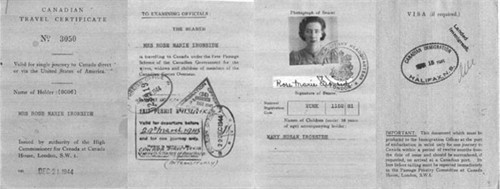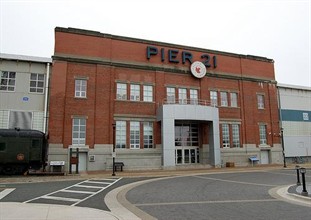Pier 21 and Canada’s War Brides
Departures and Arrivals_327x243.jpg)
Imagine that it is March 8th, 1945. The Second World
War has been raging for six years, since 1939. A 29 year-old
woman and her 3 year-old daughter board the ship R.M.S.
Aquitania bound for the port of Halifax, Nova Scotia. On
board, several hundred other women and children are traveling from
Britain to Canada to escape the effects of war.
After a near week-long passage across the frigid North Atlantic
Ocean, the refugees disembark onto Canadian soil at Halifax's Pier
21. Though the crossing was cloaked in secrecy, the
passengers are aware that this is Canada's main entry point for
immigrants, and as such, they will endure several hours of
processing by Canadian immigration officials. After
presenting the authorities with a Canadian Travel Certificate, the
document is stamped with the words "landed immigrant." These
brave women and children are past the first step in a process that
will help define their new life in an unfamiliar country.
Geographic and Historic
Context
What is Pier 21? It consists of three transit sheds
(Piers 20, 21, and 22) forming part of the Passenger Landing Quay
of the Halifax Ocean Terminals. Though these
transit sheds are described as "piers," the structures don't extend
into the harbour but are built on a seawall that parallels the
shoreline.
Construction began on these buildings in 1912-13, but was put on
hold after the Halifax explosion in 1917. Work resumed in
1926 on the two-storey Pier 21 structure and adjacent annex
building, along with Piers 20 and 22, which were completed in
1928. These structures housed the principal Canadian
immigration reception and processing facility. Though special
passenger trains departed directly from here, there was also a
nearby railway station (built ca. 1928-30) which was
used as an additional waiting area for travellers. Overall,
from 1928-1971, this was the Canadian hub of immigrant
arrivals.
 During the Second World
War, these facilities were transformed into Canada's major
departure point for troops sailing to fight in Europe. Pier
21 was an ideal military staging area for several reasons: it was
close to the railway station and numerous existing Halifax military and dockyard facilities; the seawall
could accommodate large troopships; and, Halifax was the closest
safe deep-water port to Europe. Because of these factors, nearly
500,000 armed forces service personnel passed through Pier 21 facilities. Pier 21 was also the
focus of an effort by the Canadian Government to facilitate the
safe passage of nearly 50,000 war brides and their 22,000 children
(war bride statistics).
During the Second World
War, these facilities were transformed into Canada's major
departure point for troops sailing to fight in Europe. Pier
21 was an ideal military staging area for several reasons: it was
close to the railway station and numerous existing Halifax military and dockyard facilities; the seawall
could accommodate large troopships; and, Halifax was the closest
safe deep-water port to Europe. Because of these factors, nearly
500,000 armed forces service personnel passed through Pier 21 facilities. Pier 21 was also the
focus of an effort by the Canadian Government to facilitate the
safe passage of nearly 50,000 war brides and their 22,000 children
(war bride statistics).
From Britain to Canada: One War
Bride's Experience
In the fall of 1940, just outside London, England, when
Trinidadian-born British citizen Rose Marie Potter married a
Canadian armed forces engineer named Alexander Ironside, little did
she know that she was part of a growing trend: 1,222 other British
women married Canadian soldiers that year. And because most
Canadian troops were stationed in England for three years before
they saw any active duty, there were many more marriages of this
kind, a figure that swelled dramatically by 1945 (marriage statistics).
In 1942, the Canadian government decided to provide free passage
to Canada for dependents of Canadian military personnel, and it
would help ensure that families were reunited after the war.
Each dependant was entitled to a single one-way passage from their
current British home to a new one in Canada. In 1944, Canada
declared that all military dependents would be granted Canadian
citizenship, allowing the Canadian Emigration Branch to make
settlement arrangements with Canadian family
members.
While an army of soldiers was overseas, a different army of
immigration workers and volunteers addressed the needs of war
brides impacted by the conflict. Numerous application forms
had to be completed; medical exams were taken; registration and
travel documents were drawn up. When space on ships
opened up, war brides and their children were transported to the
ship, given the necessary documentation, and handed train tickets
to a Canadian destination where their husband's family would be
waiting to welcome them. War Brides were placed on a travel
priority list according to the status of their husbands from
"discharged soldier" to "normal" (soldier still overseas). 
When Rose Marie Ironside learned in late 1944 that her husband
would be sent to Belgium, she applied to go to Canada.
At the High Commissioner's office in London, the
Canadian government issued her a travel certificate on December 21,
1944. Like a passport, it provided basic travel details.
While awaiting word of her departure, the Canadian Wives Bureau in London sent Rose a 40
page pamphlet entitled "Welcome to War Brides" with information on
practical issues: immigration procedures, how to apply for
social assistance, and details on Canadian cultural
customs.
The British Foreign Office validated Rose's travel certificate
on December 29 and 30, 1944. Another stamp indicated that an
exit permit allowed for departure anytime up to March 29,
1945. Rose wasn't told about the journey's details until two
days before the departure. On March 6th, she and
her daughter travelled from London on a non-stop train to Greenock,
Scotland, arriving on March 7th. Another stamp by British
immigration officials indicates that embarkation occurred on March
8, 1945, at the Port of Clyde, Scotland. As with most
official plans during wartime, the trip was made in secret, because
German U-boats patrolled the North Atlantic Ocean waiting to
torpedo un-protected passenger ships. So when Rose's daughter
said at one stage of the journey "We're going to Canny!" she was
quickly told to be quiet.
On board the R.M.S Aquitania, travellers were comforted
by Canadian Red Cross Escort Officers.
Rose and her daughter were among the 7,972 women and
3,705 children who travelled to Canada in 1945. In 1946, the
combined figure was higher: 31,000 made the trip, a staggering 71%
of the total for immigration to Canada that year!
Pier 21 Site Facilities, March
1945
Upon their arrival to Halifax, war brides entered Pier 21, and
then proceeded to the Immigration Annex Building. Situated
parallel to Pier 21 and separated from it by railway tracks and
accessed by two overhead walkways, the Immigration Annex was a
one-storey building resembling a medium-sized train station. It
housed various immigration, transportation and social
services. While waiting to be processed by Canadian
Immigration officials, the refugee arrivals waited on long wooden
benches.
Additional entry procedures sped up processing. Halifax's
Embarkation Transit Unit Movement Control, composed mainly of Red
Cross workers, helped war brides find special trains scheduled to
transport them to other parts of Canada, and notified Canadian
families to ensure that they would be waiting for the new
arrivals.
Rose and her daughter waited here an entire day before boarding
a train bound for Toronto. Seventeen hours later, on March
18th, 1945, they arrived with other war brides at
Toronto's Union Station where they were greeted by family
members and the media. Rose's husband arrived in Toronto in
June 1945, and life in Canada truly began for the reunited
family.
Pier 21 Today
 Today, Pier 21 is a
National Historic Site. Although immigrants no longer pass
through its halls, thousands of new visitors now visit the site
which was officially opened as the Canadian Museum of
Immigration at Pier 21 on Feb. 7, 2011. Before this, the Pier
21 Society ran an active research facility here for over ten
years. Research historians do original research in
addition to providing historical support for museum projects /
exhibits as well as dealing with external requests for information.
Research interests range from the history of the building to
accounts of denial, detention and deportation, to stories of
various ethno-cultural groups that came to Canada.
Today, Pier 21 is a
National Historic Site. Although immigrants no longer pass
through its halls, thousands of new visitors now visit the site
which was officially opened as the Canadian Museum of
Immigration at Pier 21 on Feb. 7, 2011. Before this, the Pier
21 Society ran an active research facility here for over ten
years. Research historians do original research in
addition to providing historical support for museum projects /
exhibits as well as dealing with external requests for information.
Research interests range from the history of the building to
accounts of denial, detention and deportation, to stories of
various ethno-cultural groups that came to Canada.
The research collection is focused on living history, with
approximately 700 oral histories (and counting), a few thousand written submissions, several thousand archival
images, and a small collection of physical and archival
artefacts. For anyone who is interested in specific
immigration histories check out the on-line "culture trunks" about
the travel experiences of those from the Netherlands and Hungary.
Dedicated to telling the remarkable stories of immigrants as
they arrived in Canada during the 20th century, the new
Pier 21 museum is an historic place that is well worth a virtual or
in-the-flesh visit!